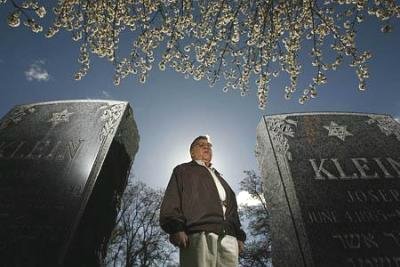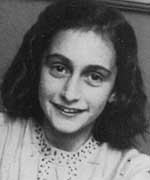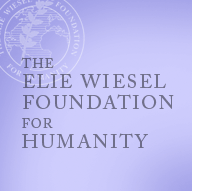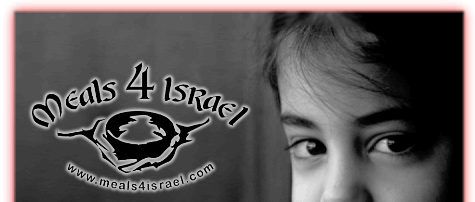The Holocaust - From Dachau and Israel to
Salt Lake City

|
Ira
Tannenbaum, who helps oversee three Jewish cemeteries
in Salt Lake City, attended the burial of two skulls taken
nearly 62 years ago from the Dachau concentration camp.
Knowing they are at rest helped World War II veteran and
retired U. professor Lloyd McCleary's peace of mind. (Francisco
Kjolseth/The Salt Lake Tribune )
|
By Jessica Ravitz
The Salt Lake Tribune
Salt Lake City----April 17...... The morning sun dried the dew
as Ira Tannenbaum, 81, walked through the cemetery atop the
Avenues, one of the three Jewish burial grounds in Salt Lake
City he helps oversee. Beyond the headstones inscribed with
Hebrew lettering and the Star of David, he stopped at an unmarked
spot where community members had gathered late last month.
He had watched as Art Warsoff, pickax in hand, labored to help
dig a hole 5 feet long, 3 feet wide and 4 feet deep. Warsoff
stood at the bottom of the grave and reached for a sealed cardboard
box. Inside, wrapped in tissue, were two skulls from the Dachau
holocaust concentration camp.
Carefully, he placed the box in the center of the hole.
There's no knowing whether the two skulls belonged to Jews.
Dachau held others, including German dissidents, Jehovah's Witnesses
and homosexuals. But definitively knowing the skulls' backgrounds
didn't matter to those at the grave site.
"It was the right thing to do," Warsoff, 46, said.
"They could have been Jewish, could have been Gypsy, could
have been anything, but at least they're in a good place."
And nearly 62 years after he took the skulls from Dachau, Lloyd
McCleary can rest knowing they rest, too.
McCleary was a 21-year-old lieutenant on the road to Munich
when he first learned about the concentration camp.
It
was April 29, 1945.
Members of the 42nd Rainbow Division had just captured a German
major. The enemy looked at the American GIs and guessed they
were on their way to Dachau.
"Dachau?" McCleary remembers thinking. They'd never
heard of such a place.
Another soldier radioed intelligence and passed along the command:
"Get to Dachau as fast as you can," McCleary says,
recalling the order. He climbed behind the wheel of his 222nd
Infantry jeep and sped off.
More than six decades later, McCleary, now 82, sits in a Salt
Lake City coffee shop and tells his story - parts of it for
the first, and he vows only, time. In helping to liberate Dachau,
the prototype Nazi holocaust concentration camp, he saw horrors
he says others can't comprehend. How could they? Why would they
want to?
Dead bodies the furnaces couldn't consume fast enough were roof-high,
"stacked like cordwood," he says. Locked boxcars,
which had sat on the train tracks for days, maybe weeks, were
opened to reveal thousands of tangled skin-and-bone men, women
and children - half were corpses, most of the others died in
soldiers' arms.
Some surviving camp prisoners, finally tasting freedom, unleashed
their pent-up rage, attacking and killing about 40 SS guards.
Some they drowned in Dachau's moat, the GI remembers. McCleary
watched as one prisoner beat the brains out of a guard, using
a wooden leg as his weapon.
And the camp's stench? Indescribable.
Hardened soldiers retched and fell apart around him. A news
correspondent vomited as he typed, balancing a manual typewriter
on the hood of McCleary's jeep. His colonel, McCleary found
out later, never recovered. The man cracked, would never again
smell meat cooking without throwing up, attempted suicide at
least once and died before turning 40.
"I'm sure I had a lot of post-traumatic stress for years,
maybe still do, but it didn't incapacitate me like my colonel,"
McCleary says. "And he was a West Pointer."
The retired University of Utah professor somehow held it together.
He's not sure why or how; he just did. Maybe he was callous
from his time fighting on the front lines, in shock or numb,
but the piles of dead bodies didn't faze him, he says. When
he walked into what he describes as a "medical room,"
however, something else did. Two skulls, likely remnants of
prisoners used for medical experiments, sat in the stark room.
McCleary could only speculate as to what these people had been
through. "Why were they there?" he wonders out loud.
"I didn't know, but I wasn't going to let them get pitched
into a pit."
The box in the house's furnace room, marked "skulls,"
always seemed a little strange.
"It was the kind of box you tried to avoid," says
McCleary's youngest, Victoria "Vicki," 43, of Salt
Lake City.
As a child, she remembers asking her father why he brought the
skulls home. His response, she recalls: "I wanted to remember
these things really happened...It wasn't a figment of my imagination."
The nightmares that woke him in the war's aftermath often left
him wondering if what he saw was real. The proof, his daughter
says, was in the box.
About 20 years ago, Vicki joined her dad on a trip to Dachau,
one of a few return trips he has made since World War II. He
complains about how "sterile" the camp is today. Most
of the barracks are gone, there's no remnant of the moat, and
visitors would never know about that trainload of corpses and
dying people, he says. He'd always spoken about his wartime
experiences, Vicki says, but he had skimmed over his time at
the concentration camp. Even so, Vicki - the youngest by 12
years - knows more than her older sisters. For some reason,
she says her dad began to open up as he got older.
The skulls no longer scared Vicki by the time she got to college.
In fact, they sort of came in handy. She was studying anthropology
at the U. and brought them to her osteology class. Her father,
incidentally, had done something similar when he returned from
war.
McCleary was a student at the University of Illinois and enlisted
in the reserves when he was called up for service in 1942. He
arrived in southern France in September 1944 and would not return
from Europe until June 1946. Right after he left Dachau, on
April 30, 1945, he was sent - without his jeep, his belongings
and, consequently, the skulls - to regimental headquarters outside
of Salzburg, Austria, where he became a staff officer. But members
of his regiment had held onto his things, and "six months
later, the skulls caught up with me," he says.
He had no idea what he was going to do with them but says he
knew he had to do something. Once back in school, he enrolled
in a physical anthropology class, specifically to learn more
about the skulls, about these two people who had died at the
hands of Nazis. The one with a bullet hole above the left brow,
he explains with his finger cocked to his forehead, belonged
to a woman in her mid-30s. The other was a male, likely in his
late-50s. The anthropology department wanted to keep the skulls,
but McCleary maintained they deserved more - "a ritual,
a religious ceremony or something," he says.
He sought counsel from Methodist preachers, including his brother,
as well as a Catholic priest, but no one seemed to have answers
or adequate interest. So he wrapped the skulls in tissue, tucked
them in a box, sealed it and went on with his life. In 1970,
he moved to Salt Lake City, where he became a professor and
chairman of educational administration at the U. until 1994.
As the years passed, McCleary thought about the skulls from
time to time. The responsibility never left him. In the past
couple of years, the urgency to act grew. He didn't want to
die without taking care of this business.
The Rev. Ivan Cendese was instrumental in helping him move forward.
The former Catholic priest, longtime educator and administrator,
and, as of 1989, Episcopal priest has known McCleary for years.
He was a doctoral student of the professor's in the late 1970s
and early '80s, and the two became friends. During a 2005 teaching
stint at Salt Lake City's Rowland Hall-St. Mark's School, Cendese
invited McCleary to speak in a Western civilization class about
his service in World War II.
During that speech, McCleary says he mentioned the skulls in
front of Cendese for the first time. He turned to his friend
for advice. The two met for coffee, and Cendese promised to
help McCleary figure this out. The skulls that had followed
McCleary for nearly 60 years were now in Cendese's hands.
The call from the priest was unlike any Rabbi Tracee Rosen,
of Salt Lake City's Congregation Kol Ami, had ever received.
Six decades after the Holocaust, how was she to know what to
do? She didn't have the answer, but she was certain she could
find one. The skulls, still in their sealed box, became hers.
On a visit to the U.S. Holocaust Memorial Museum in Washington,
D.C., several months later, Rosen asked around. She was told
the most respectful and responsible thing she could do would
be to give the skulls a Jewish burial. Now it was just a question
of figuring out the right time and place.
Every year or so, members of Salt Lake City's Jewish community
cull together materials for a special ceremony. It's customary
in Judaism to bury damaged sacred items or text containing God's
name in Hebrew. Holy words, it's believed, deserve the same
respect as departed individuals.
The Dachau skulls, it turned out, would not rest alone.
Rosen explained it once was common to bury sacred text and items
with righteous people, as an act of added tribute. So as the
group placed around the box of skulls the community's damaged
prayer books, prayer shawls and copies of Torah readings, they
gave the two from Dachau extra blessings.
The impression in the Jewish community was that the anonymous
veteran was ashamed of his actions, that he'd taken the skulls
as "souvenirs" and had confessed - on his deathbed
- to a priest. With his gym bag beside him, having just finished
one of his regular workouts, McCleary wants the truth to be
known.
"I don't want anyone to think I did this on a whim. . .
. I have no regrets," he says. "I was trying to do
the right thing all along."
Sixty-two years ago, amid the mayhem that was Dachau's liberation,
countless tangled corpses unceremoniously filled ditches. For
the two skulls left in a medical room, McCleary wanted more.
And now that they've been buried, dignified with a ritual and
prayers, he can finally let go.
JESSICA RAVITZ can be reached at jravitz@sltrib.com
YOM HASHOAH: HOLOCAUST MEMORIAL DAY
Of the estimated 15 million people killed by the Nazi regime,
6 million were Jews. The Jewish people were the only ones targeted
for complete extermination. By the end of the war, about two-thirds
of European Jewry, or a third of world Jewry, were gone.
This evening marks the beginning of Yom HaShoah, or Holocaust
Memorial Day, which is observed on the 27th day of Nissan, the
first month on the Hebrew calendar. Israel law established this
day of remembrance in the 1950s. There are no fixed rituals
for observance, except in Israel, where a two-minute air-raid
siren will sound throughout the nation Monday at 10 a.m. Wherever
people are - at work, in traffic, on the beach - they will stop
to stand in silence and honor the dead. Pedestrians freeze in
their tracks, buses stopped on busy streets, and cars on major
highways pulled over as the country paused to pay respect to
the six million Jews killed by the Nazis.
All
day, television stations devoted their broadcasts to historical
documentaries and movies, and radio stations played sombre music
and interviews with survivors.
The
State of Israel marked the start of Holocaust Remembrance Day
yesterday evening in memory of the six million Jews murdered
by the Nazis and their helpers, as well as those who rose up
in revolt against the Nazi barbarism.
The
annual state ceremony begin at 8 p.m. at the Israel Yad Vashem
Holocaust Memorial in Jerusalem..
The
solemn hour-long opening event, was broadcast live on national
television channels and radio, and was attended by Prime Minister
Ehud Olmert and Acting President Dalia Itzik, as well as scores
of dignitaries and ambassadors from around the world.
The
Israel government, in cooperation with the Israel Yad Vashem
Holocaust Memorial in Jerusalem stated that the central theme
for this year’s Holocaust Martyrs’ and Heroes’
Remembrance Day would be Bearing Witness. The Official Opening
Ceremony for Holocaust Martyrs’ and Heroes’ Remembrance
Day took place at 20:00, at the Warsaw Ghetto Square, Yad Vashem,
Har Hazikaron in Jerusalem.
Israel’s
Acting President Dalia Itzik and Israel Prime Minister Ehud
Olmert addressed the participants. Avner Shalev, Yad Vashem
Chairman, kindled the Memorial Torch. Joseph (Tommy) Lapid,
Chairman of the Yad Vashem Council, spoke on behalf of the survivors.
He said simply, “I was there.”
Pointing
out that the "People of Israel are One," he added,
“All of us were there. All of us were in the Holocaust,”
and he warned that anti-Semitism is rampant in Europe, Japan
and Muslim nations. He also exhorted the Jewish nation notto
"sit with hands folded” while other people, such as
those in Darfur, are being threatened with mass extermination.
Israel
Prime Minister Ehud Olmert said that Israel celebrates its 59th
independence day next week.
"The renewal of the Jewish people, its shaking off the
ashes of the Holocaust for a new life and national rebirth in
its historic birthplace, is the pinnacle of its victory,"
he said.
The
Israel Holocaust ceremony was broadcast live on Israel television
on Channels 1, 2, 10 and 33 and by Israel radio on Kol Israel
and Galei Zahal, and on www.yadvashem.org.
INSIDE THE DACHAU CONCENTRATION CAMP
The Dachau concentration camp, located northwest of Munich,
Germany, opened in 1933. Initially, it was intended to house
political dissidents such as communists and trade unionists.
In subsequent years, however, an ever-increasing number of Jews
- as well as Gypsies, homosexuals and others - also were imprisoned
there.
Dachau, which included scores of subcamps, was the model for
future camps, explains Aaron Breitbart, a senior researcher
at the Los Angeles headquarters of the Simon Wiesenthal Center,
an international Jewish human rights organization. He says that
while people point to Auschwitz when they think of horrors such
as medical experimentation, Dachau was where experiments began.
As the Nazis ramped up efforts to systematically exterminate
the Jewish people, after the Wannsee Conference of January 1942,
some 2 million Jews were gassed in Auschwitz-Birkenau and Treblinka,
two of the death or extermination camps. Dachau was different
in that the gas chambers were never used, Breitbart says.
"It was not a death camp in the sense that it had a mass
murder machine," he says. "It was a death camp in
that that's what you were supposed to do there."
Officially, 206,000 prisoners were registered at Dachau, and
31,591 deaths were recorded on the books, Breitbart says. But
the researcher adds that verifying numbers is impossible and
that these figures fail to tell the whole story. More likely,
he estimates about 50,000 died at Dachau by way of, for example,
sickness, starvation or shooting. At the time of liberation,
the Associated Press reported that 32,000 prisoners were freed.







